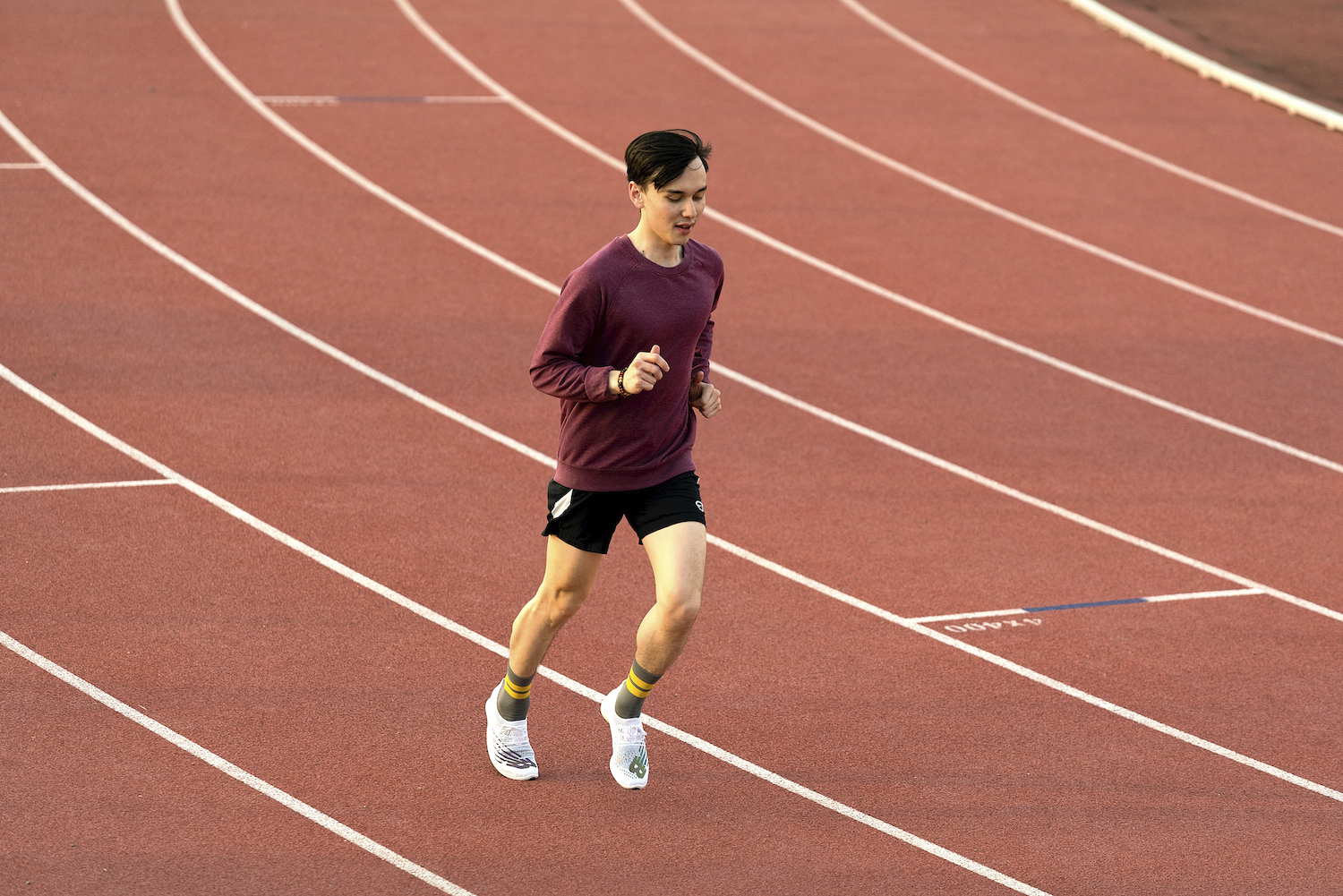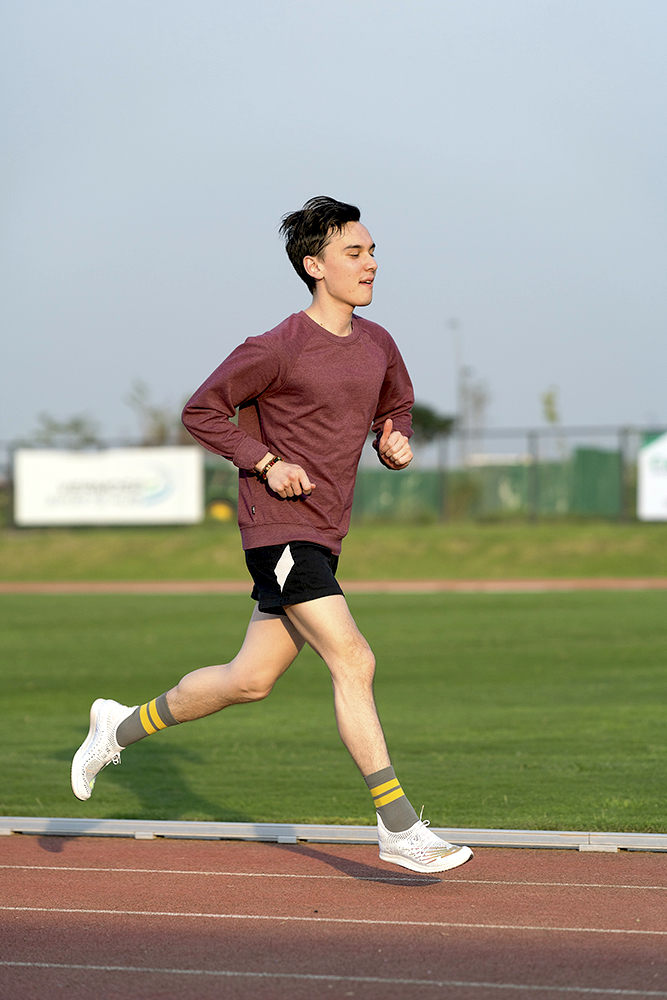Chances are high that you’re reading this while craned over your phone with your head hoisted over your chest and held up by your neck.
You’d be slightly better off if you had a computer propped open on your desk with your shoulders back and your eyes gently gazing forward at your screen. And that surely is something you’ve already heard of.
The idea, after all, that you should maintain proper posture while working or browsing on your phone is nothing new. This is what Gavin Burt of Runner’s World calls “static posture,” the sort that extends your neck high above your shoulders and signals both confidence and a wonderfully straight spine.
The posture I’m going to be plunking away at my keyboard is what Burt calls “dynamic posture,” which refers to the efficiency with which we move—a key to running more comfortably, longer distances, and faster.
I tend to run hunched over

In the same way I guessed you were reading this, I tend to tip the top part of my body from the top of my head to the middle of my torso just under my chest forwards.
While running, I have a tendency to look at the ground a few steps in front of myself. I’m not exactly a role model for posture but perhaps I can toss my hat into the ring of “I’m trying my best to improve.”
I’m well aware that I’m wasting large amounts of energy on my runs. With my hunched-over shoulders, I tend to direct a lot of it through my feet downwards and into the ground. This prevents me from transitioning from foot to foot smoothly with a gentle roll of the midfoot to forefoot.
Instead, I’m using my quadriceps even more heartily than I otherwise would be to get my feet up off the ground and into the next cycle of steps to bring myself forward.
Not an expert, of course. But that’s exactly how it feels.
Hence, on recent runs, rather than trying to rally my cadence up, I’ve focused on relaxing my shoulders, puffing out my chest with just enough confidence, and keeping my gaze on the distance in front of me.
I’ve been using some excerpts from a Marathon Training Academy article as my guide: “Properly align your neck and back by looking straight ahead and keeping your chin parallel to the ground. Avoid looking down… Keep your back straight and your shoulders relaxed. Do not lean backward. Let your arms swing forward and backward on your sides while keeping your torso stable.”

This may seem simple, but it has been a large shift in focus: Increasing our cadence, or number of steps per minute, requires grunt effort, while relaxing our shoulders and aligning our spine is a form of letting go.
Focus on dynamic posture for the sake of sustainable running
Not all my runs have been faster than usual with this renewed focus. But I have noticed fewer aches and pains between running sessions. When it’s time for my faster efforts, I feel less strain on my body and more focus on the motion I’m utilizing to get myself moving.
Per the abovementioned Marathon Training Academy pointers, running with proper posture improves not only running efficiency but also prevents injury. While keeping our spine aligned allows our lungs to expand to their full capacity—and thereby improving our endurance—running in proper form puts less strain on our joints and muscles that may otherwise be at risk for strains that hinder training.
On the question of how we can markedly improve running posture, we need to think about our strides, our arms, knees and neck, and a drills routine.
Tips for improving dynamic posture
Aim for 180 (or thereabouts)
While many folks write about 180 footstrikes per minute being the golden standard of efficient running, which uses the hip joints in the most fluid way, runner, exercise scientist, and coach Greg McMillan argues that the sweet spot is around 170 to 190 footstrikes per minute and that strides are key workouts for building up cadence.
“Strides are fast but controlled runs over very short distances where you work on excellent running form,” he writes. “They are not all-out sprints and you should not get out of breath doing them.” He recommends eight to 10 strides over 100 meters with a 20-minute cooldown and that you should do this sort of workout two to three times a week.
Try not to twist
“One of the distinctions between us as mammals and reptiles,” writes Gavin Burt of Runner’s World, “is that reptiles walk using a side-bending motion with their elbows and knees out to the side of their bodies (just look at the way a lizard bends when it walks).”
Focus on bringing your knees and arms up and down rather than from side-to-side while you’re on a run. Your elbows should be tucked tighter toward your body, keeping you from swinging your torso (and using more energy to hold your spine in place).

Look forward
I’ve noticed that when my mind isn’t in the best of places, I direct my gaze at the ground in front of me and focus my attention on just getting the run done. When I make the extra effort to look forward with a gentle focus a few more steps ahead, my runs feel smoother—as though I’m devoting less effort to getting my legs moving. Burt’s advice? “…imagine you were looking up at the first floor of a house that was a hundred yards in front of you.”
And incorporate drills into your running routine
Ben Parkes, a 2:25 marathoner, 67:48 half-marathon runner, and coach, recommends a routine of drills twice a week before easy runs to improve form and efficiency, build leg strength, prevent injury, increase cadence, and build speed.
While building running strength is often measured most apparently through roaringly fast times on fitness monitoring applications, small tweaks sustained over time build lasting results with fewer injuries. Try some of these simple drills on easy run days:
Butt kicks – Draw your knee up in a straight line toward the bottom of the butt
High knees – Alternate bringing each knee above your waist
A-skip – Skip forward bringing your knee up above your waist and switch to your other leg
B-skip – Just like an A-skip but extend your knee after bringing it up
Carioca – Exactly as it was in high school
There is a whole wealth of workouts available online, too. You may find a simple workout from Ben Parkes here or a more advanced set of drills from 15-time Xterra USA national champion and 2015 Xterra world champion Josiah Middaugh here.
You will always be tempted to simply “gun it”
Usually if I intend to run calmly but end up throwing my whole force behind it, I say “I gunned it.” And on slower runs where I focus on my form, I’m always tempted to do exactly that. But that’s not the sort of training that builds a stronger mind and body over time.
There is a distinction between feeling it and having a wonderfully strong run and just giving each run of your weekly training your whole effort.
Incorporating drills and a conscious effort to improve form into your running routine is a step to both improving your running strength and running sustainably—with fewer injuries and fewer lapses in motivation.
And they’re great additions to the days you focus on running calmly.
Try out some sample drills below:
Photos by RG Medestomas
This story was first published on multisport.ph









































